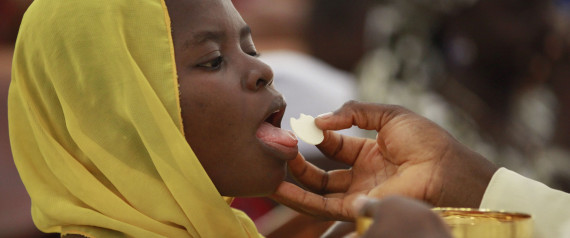The late Loraine Boettner, the dean of anti-Catholic Fundamentalists, said the Mass is a "jumble of medieval superstition."
Fundamentalists insist that when Christ says, "This is my body," he is speaking figuratively. But this interpretation is precluded by Paul’s discussion of the Eucharist in 1 Corinthians 11:23–29 and by the whole tenor of John 6, the chapter where the Eucharist is promised. The Greek word for "body" in John 6:54 is sarx, which means physical flesh, and the word for "eats" (trogon) translates as "gnawing" or "chewing." This is certainly not the language of metaphor.
No "figurative presence"
The literal meaning can’t be avoided except through violence to the text—and through the rejection of the universal understanding of the early Christian centuries. The writings of Paul and John reflect belief in the Real Presence.
There is no basis for forcing anything else out of the lines, and no writer tried to do so until the early Middle Ages. Christ did not institute a Figurative Presence.
Some Fundamentalists say the word "is" is used because Aramaic, the language Christ spoke, had no word for "represents." Those who make this feeble claim are behind the times, since, as Cardinal Nicholas Wiseman showed a century ago, Aramaic has about three dozen words that can mean "represents."
The Catholic position
The Church teaches that the Mass is the re-presentation of the sacrifice of Calvary, which also is invariably misunderstood by anti-Catholics. The Catholic Church does not teach that the Mass is a re-crucifixion of Christ, who does not suffer and die again in the Mass.Loraine Boettner mounts another charge. In chapter eight of Roman Catholicism, when arguing that the meal instituted by Christ was strictly symbolic, he gives a cleverly incomplete quotation. He writes, "Paul too says that the bread remains bread: ‘Wherefore whosoever shall eat the bread and drink the cup of the Lord in an unworthy manner. . . . But let each man prove himself, and so let him eat of the bread, and drink of the cup’ (1 Cor. 11:27–28)."
The part of verse 27 represented by the ellipsis is crucial. It reads, "shall be guilty of the body and blood of the Lord." Why does Boettner omit this? Because to be guilty of someone’s body and blood is to commit a crime against his body and blood, not just against symbols of them. The omitted words clearly imply the bread and wine become Christ himself.
Profaning the Eucharist was so serious that the stakes could be life and death. In the next two verses (29–30), Paul states, "For any one who eats and drinks without discerning the body eats and drinks judgment upon himself. That is why many of you are weak and ill, and some have died."
Boettner’s omitted statements reveal that when Paul uses the term "bread," he’s using the language of appearances, what scholars call "phenomenological language."
In this form of speech, something is described according to how it appears, rather than according to its fundamental nature. "The sun rose," is an example of phenomenological language. From our perspective, it appears that the sun rises, though we know that what we see is actually caused by the earth’s rotation.
Scripture uses phenomenological language regularly—as, for example, when it describes angels appearing in human guise as "men" (Gen. 19:1-11; Luke 24:4–7, 23; Acts 1:10–11). Since the Eucharist still appears as bread and wine, Catholics from Paul’s time on have referred to the consecrated elements using phenomenological language, while recognizing that this is only description according to appearances and that it is actually Jesus who is present.
We are not merely symbolically commemorating Jesus in the Eucharist, but actually participating in his body and blood, as Paul states, "The cup of blessing which we bless, is it not a participation in the blood of Christ? The bread which we break, is it not a participation in the body of Christ?" (1 Cor. 10:16).
MORE



1 comment:
Hear the word of the LORD, princes of Sodom! Listen to the instruction of our God, people of Gomorrah!
What care I for the number of your sacrifices? says the LORD.
I have had enough of whole-burnt rams and fat of fatlings; In the blood of calves, lambs and goats
I find no pleasure.
When you come in to visit me, who asks these things of you? Trample my courts no more! Bring no more worthless offerings; your incense is loathsome to me.
New moon and sabbath, calling of assemblies, octaves with wickedness: these I cannot bear.
Your new moons and festivals I detest; they weigh me down, I tire of the load.
When you spread out your hands,
I close my eyes to you; Though you pray the more, I will not listen.
Your hands are full of blood!
Wash yourselves clean!
Put away your misdeeds from before my eyes; cease doing evil; learn to do good.
Make justice your aim: redress the wronged, hear the orphan's plea, defend the widow. (Isaiah 1:10-17)
Post a Comment